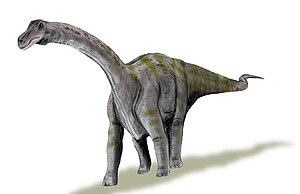Rapetosaurus
| Rapetosaurus | ||||||||||||
|---|---|---|---|---|---|---|---|---|---|---|---|---|

Live graphic representation of Rapetosaurus |
||||||||||||
| Temporal occurrence | ||||||||||||
| Upper Cretaceous ( Maastrichtian ) | ||||||||||||
| 72 to 66 million years | ||||||||||||
| Locations | ||||||||||||
| Systematics | ||||||||||||
|
||||||||||||
| Scientific name | ||||||||||||
| Rapetosaurus | ||||||||||||
| Curry Rogers & Forster, 2004 | ||||||||||||
| Art | ||||||||||||
|
Rapetosaurus was a sauropod dinosaur from the Titanosauria group thatlived inwhat is now Madagascar at the end of the Upper Cretaceous ( Maastrichtian ).
It is the only titanosaur whose skeleton, including skull, is almost completely known - therefore Rapetosaurus is of outstanding importance for the understanding of these dinosaurs, which are usually very incomplete . Like all sauropods, Rapetosaurus was a four-legged herbivore .
Rapetosaurus was scientifically described by Curry Rogers and Forster in 2004. The only known species of this genus is Rapetosaurus krausei . The genus name Rapetosaurus ("Rapeto lizard") is named after Rapeto, a giant of the Malagasy folk myths, while the epithet krausei honors David Krause, the leader of the expedition that found the bones.
Find
All in all, skull material of an adult animal and a young animal was found, in addition, the skeleton of a young animal, including its skull, preserved to 75%, was found. The fossils come from the Maevarano formation not far from the port city of Mahajanga in north-western Madagascar. The rock strata belong to the Anembalemba strata of the Maevarano Formation; Other finds of this layer member include the remains of theropod dinosaurs (e.g. Majungasaurus ), crocodiles , turtles , snakes , mammals , frogs and fish .
Sauropods were found from the Maevarano formation over a century ago - the French paleontologist Charles Depéret (1896) described the species "Titanosaurus" madagascariensis on the basis of scanty remains. Although Titanosaurus madagascariensis is now considered to be the noun dubium , the bones show differences from the Rapetosaurus bones, which shows that at least two different sauropods were present in the late Upper Cretaceous Madagascar.
features
The length of a fully grown Rapetosaurus is estimated to be 15 meters, the skeleton of the young animal found is only 8 meters long. The skull of Rapetosaurus was flat and elongated and equipped with pin-like teeth. This differentiated Rapetosaurus from other Macronaria , which mostly had a short-nosed skull with spatulate teeth, but resembled Diplodocoideen such as B. Diplodocus . It is likely that these traits evolved convergently in Diplodocoids as well as in some titanosaurs such as Rapetosaurus . An important autapomorphy - a feature with which Rapetosaurus can be distinguished from other genera - is the clearly elongated antorbital window (another skull window of the dinosaurs in front of the eye opening), which runs forward to over the rows of teeth.
The vertebrae of sauropods are among the most important parts of the skeleton for diagnosis, as they are provided with various cavities, which vary from species to species and which may once have been filled with air sacs . Rapetosaurus had at least 15 cervical vertebrae, the front ones being elongated - towards the back the cervical vertebrae were short and wide. The 10 vertebrae were strongly opisthocoel (hollowed out on the back) and also had deep hollows on the sides. The 6 pelvic vertebrae were also opisthocoid and not fused to one another in the skeleton found. Although 18 middle and posterior caudal vertebrae have been found, many vertebrae have not been recorded and their total number is therefore unknown. The found caudal vertebrae are strongly procoel (hollowed out on the front side) and have quite high vertebral processes pointing upwards.
The basin is characterized by a short ischial from (ischium) that only 54% of the length of the pubic bone has (pubis). The acetabulum is mainly formed by the ilium and the pubic bone, with the ischium only making up a small proportion. The foot bones were found in an anatomical network - of the five toes, the third is the longest, while the fifth is very small and triangular.
Systematics
Often Rapetosaurus is classified within the family of Nemegtosauridae , which consists of the genera Nemegtosaurus and Quaesitosaurus . Both genera are known from isolated skulls, which - like Rapetosaurus - have clear analogies to Diplodocoideen. The family is therefore traditionally classified within the Diplodocoidea. With the discovery of Rapetosaurus it was possible for the first time to examine a Nemegtosaurid skull in connection with the remaining skeleton - this confirmed the theory, which is now recognized by many researchers, that Nemegtosaurids are titanosaurs.
literature
Unless otherwise stated, all information comes from the following publication:
- Kristina Curry Rogers: Titanosauria: A Phylogenetic Overview. In: Kristina Curry A. Rogers, Jeffrey A. Wilson (Eds.): The Sauropods. Evolution and Paleobiology. University of California Press, Berkeley CA et al. 2005, ISBN 0-520-24623-3 , pp. 50-103, doi : 10.1525 / california / 9780520246232.003.0003 .
Individual evidence
- ↑ Kristina Curry Rogers: The postcranial osteology of Rapetosaurus krausei (Sauropoda: Titanosauria) from the Late Cretaceous of Madagascar. In: Journal of Vertebrate Paleontology. Vol. 29, No. 4, 2009, ISSN 0272-4634 , pp. 1046-1086, doi : 10.1671 / 039.029.0432 .
- ^ Paul Upchurch : The Evolutionary History of Sauropod Dinosaurs. In: Philosophical Transactions of the Royal Society of London. Series B: Biological Sciences. Vol. 349, No. 1330, 1995, ISSN 0080-4622 , pp. 365-390, doi : 10.1098 / rstb.1995.0125 .
- ↑ David B. Weishampel , Peter Dodson , Halszka Osmólska (eds.): The Dinosauria . 2nd edition. University of California Press, Berkeley CA et al. 2004, ISBN 0-520-24209-2 , p. 303.
Web links
- Skeleton of New Dinosaur "Titan" Found in Madagascar , article by National Geographic, in English.
